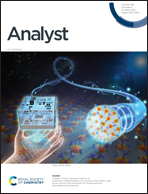Development of an exogenous coreactant-free electrochemiluminescent sensor for sensing glucose†
Abstract
Covalent organic frameworks (COFs) are crystalline porous polymers with the characteristics of a large specific surface area, controllable pore structures, high stability, and low mass density. Herein, we demonstrate the development of an exogenous coreactant-free electrochemiluminescent sensor based on a hydrazone-linked COF for sensing glucose. We synthesized a TFPPy-DMeTHz-COF with the hydrazone bond as the linkage and 2,5-dimethoxyterephthalohydrazide (DMeTHz) and 1,3,6,8-tetrakis(4-formylphenyl)pyrene (TFPPy) as the monomers. The obtained TFPPy-DMeTHz-COF exhibits high electrochemiluminescence (ECL) efficiency (21.7%) without either the addition of any coreactants or the removal of dissolved O2, and the ECL signal intensity of the TFPPy-DMeTHz-COF is 6.6 and 113-fold higher than those of TFPPy and DMeTHz, respectively. The enhanced ECL emission of the TFPPy-DMeTHz-COF is induced by OH− in PBS, and the ECL signal exhibits linear dependence on the pH value in the range from 3 to 10. When glucose is present, the addition of glucose oxidase (GOx) to the O2-containing solution generates gluconic acid, and the resultant gluconic acid can induce the decrease of the pH value and the quenching of the ECL emission of the TFPPy-DMeTHz-COF. This exogenous coreactant-free electrochemiluminescent sensor exhibits good selectivity, excellent stability, and high sensitivity with a limit of detection (LOD) of 0.031 μM, and it can accurately detect glucose in human serum.

- This article is part of the themed collection: Analyst HOT Articles 2023


 Please wait while we load your content...
Please wait while we load your content...